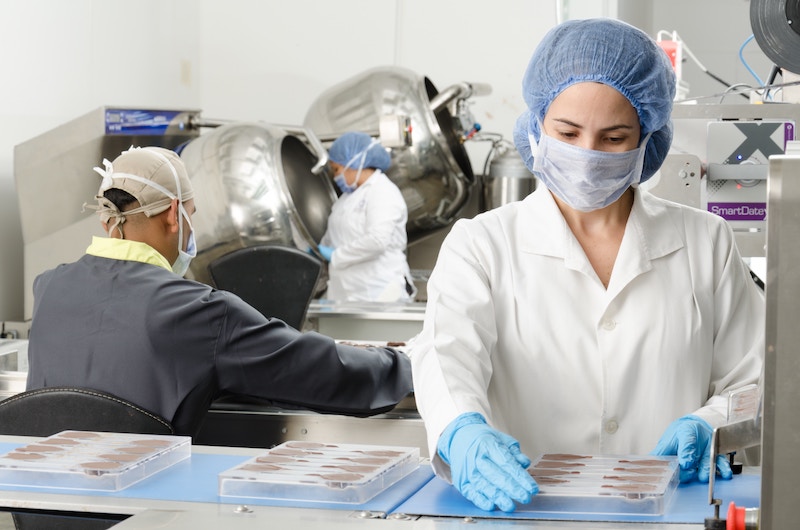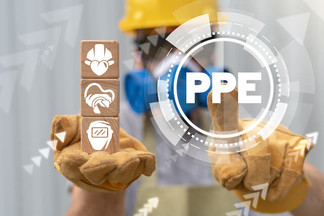Apr 18th 2023
The Importance of Wearing Personal Protective Equipment (PPE)
PPE And Its Purpose
It is essential to embrace Personal Protective Equipment (PPE) in the workplace for safety purposes. PPE encompasses any clothing or tools made to protect individuals from potential dangers such as toxic substances, flying items, and other hazardous circumstances. The main objective of PPE is to lower the danger of getting hurt, ill, or dying by providing a barrier between possible threats and the wearer. Additionally, it helps reduce contact with precarious elements and defends against high temperatures or suspended particles. Employers have a legal requirement to keep their workplace safe for employees and must determine appropriate PPE for every mission. Wearing PPE accurately is key to staying protected on-site; hence it must be appropriately picked depending on the particular job and its related risks, plus accurately worn to guarantee efficiency.
Why PPE Is Essential For Workplace Safety
Providing employees with Personal Protective Equipment (PPE) is integral to a secure workplace. It serves as a safeguard and offers an extra layer of security, especially in roles where physical interaction or hazardous substances are common. Apart from providing basic protection from injuries and spills, different types of PPE also offer advanced benefits such as enhanced visibility in poorly lit environments and defense from electric shocks. Investing in high-quality PPE is a cost-effective way for employers to limit their legal exposure, guarantee maximum safety for their staff, and give them the assurance they need to do their job without fear of harm. The safety of employees is always a top priority for any organization, so investing in quality PPE can be an effective method to mitigate potential risks.

The Different Types Of PPE Available For Use In The Workplace
Businesses must ensure the safety of their personnel by providing them with Personal Protective Equipment (PPE). The range of PPE needs can differ based on industry or environment, often consisting of protective clothing, goggles, respirators, and ear muffs. For instance, occupations such as construction, manufacturing, and agriculture often require hard hats, boots, and helmets to protect against physical risks. Goggles may be used when handling hazardous materials while respirators should be worn in areas with high levels of air pollutants or particles. Earmuffs and plugs shield individuals from noise-induced injury or hearing issues. In addition to providing PPE, companies must offer appropriate instruction on its use to make certain employees understand the risks associated with not adhering to proper protocol. Ultimately, having a thorough plan in place is essential for developing a safe and productive work environment.
How PPE Helps Protect Workers From Hazards And Risks In The Workplace
To protect the safety and health of their workers, employers must provide the necessary Personal Protective Equipment (PPE). From hard hats to safety goggles, these items decrease the chances of harm being done when utilized properly. Additionally, employers ought to ensure that their staff is taught how to wear and maintain PPE for maximum protection. While it is true that PPE can be an effective way to diminish risks in the workplace, companies should also strive to make their work environment hazard-free to safeguard their personnel.
How to Properly Utilize PPE Wear
How To Choose The Right Type Of PPE For The Job
Selecting the right Personal Protective Equipment (PPE) for a job is essential to ensure safe and effective work. Consider the environment and type of job you are doing and make sure that the PPE you choose is appropriate for the task. For example, if you are working in wet conditions, waterproof PPE might be more suitable than other types. Additionally, if you are working with hazardous materials, make sure you have the correct respirator or face shield to protect yourself from any airborne particles. It is also important to take into account comfort levels when selecting PPE; for instance, wearing a heavy-duty glove made of thick material may be better suited to the task at hand, but can cause discomfort if worn for long periods of time. Consider different options that provide the same level of protection without compromising on comfort. Lastly, always ensure that your PPE meets the necessary safety regulations and standards to guarantee that it is fit for purpose. Choosing the right PPE is essential to ensure safe and successful work, so take the time to choose the right option for the job.
The Proper Steps For Donning, Or Putting On, PPE
When donning Personal Protective Equipment (PPE) it is essential to follow the correct steps to ensure safety. To begin, start by washing your hands with soap and water for at least twenty seconds or use an alcohol-based hand sanitizer. Next, put on a disposable face mask, making sure that it covers both your nose and mouth. Then, select appropriate gloves for the task and ensure that they fit snugly but not too tight. After that, fasten any closures such as ties or straps on the protective gown, and ensure that it completely covers your torso, arms, and legs. Finally, slide a face shield or goggles over your face, ensuring a snug fit. With all these steps taken to securely protect yourself, you are now ready to safely complete the task in question.
How To Properly Wear And Adjust PPE
When wearing personal protective equipment (PPE), it is important to ensure a proper fit and securement. Start by putting on protective clothing, such as a face shield, goggles, or respirator, making sure to adjust for an individualized fit. Gently tighten straps and ties as necessary, but be mindful not to pull too tightly as this can restrict airflow. Next, don the gloves, if needed, and adjust them so they fit snugly against the wrist. Make sure to check for any tears or holes and replace any damaged gloves with a new pair. Finally, secure any loose ties, belts, and buttons to the PPE and verify the integrity of the materials. With properly fitted PPE, you are now ready to enter hazardous environments safely.
The Importance Of Regularly Inspecting And Maintaining PPE
It is paramount to inspect and maintain Personal Protective Equipment (PPE) regularly, in order to increase its life expectancy and provide adequate protection for those who use it. Thoroughly checking PPE can identify potential hazards before they become dangerous, while maintenance helps to ensure the security this equipment gives and the top-notch quality of these products. To fulfill their commitment to worker safety and remain in line with applicable laws, employers must inspect staff members and educate them about using their protective gear properly. The inspection should include a thorough visual examination for any signs of wear or damage, along with an evaluation of the working environment to make sure that suitable PPE is available. Training should encompass guidance on how to correctly put on, adjust, cleanse, and store the protective gear and how to properly discard it after usage. Regularly inspecting and servicing PPE will guarantee that personnel is safeguarded during work hours as well as that employers are meeting their duty of offering a safe workplace.
The Common Mistakes To Avoid When Wearing PPE
When tacking on protective equipment, there are a few common mistakes to be aware of to ensure safety. First and foremost, make sure that all parts of the PPE are fitted correctly and securely; a loose-fitting glove, for example, could potentially leave the hand vulnerable to injury. If the PPE is being worn for a prolonged period, take regular breaks to check for signs of discomfort or fatigue and adjust accordingly. The area should also be regularly inspected for any potential dangers or hazards that could compromise the safety of the user. On top of that, all equipment should be regularly serviced, as per the manufacturer’s instructions, to ensure that it remains up-to-date and in working order. Finally, all users of PPE must always remain aware of their environment and take necessary precautions to protect themselves from potential harm. By avoiding these common mistakes, everyone can stay safe when wearing PPE.
The Benefits Of Wearing PPE For Both Employers And Employees
The implementation of Personal Protective Equipment (PPE) in the workplace is a necessity to guarantee the safety of both employers and employees. Not only does wearing PPE shield workers from likely risks and injuries, but it also promotes a healthier and more secure environment to work. Employers can take advantage of PPE utilization by decreasing the number of workers’ reimbursement claims and leading by example with a culture of security and risk management. On the other hand, employees will benefit from using PPE through extra protection against any potential perils they might come across while on duty. Furthermore, employees can experience augmented job gratification knowing that their well-being is taken seriously. Wearing PPE not solely helps safeguard the health of employees, but also assists in diminishing the risk of costly medical expenses later on. To sum up, utilizing PPE at work is advantageous for both employers and employees alike; thus, making it an essential component of any responsible business model.
How Wearing PPE Can Help Reduce Workplace Accidents
By wearing items of personal protective equipment (PPE), such as goggles, hard hats, and steel-toed boots, workers in all types of industries can greatly reduce the risk of on-the-job accidents. These pieces of equipment are purpose-made for specific working conditions, providing better protection and confidence to personnel. PPE is effective in safeguarding against flying particles, chemical splashback, electric shocks, and more. Although putting on PPE may appear straightforward, its impact on safety at work is tremendous. Wearing it properly can prevent major injuries, shield workers, from hazardous environments, and guarantee that everyone returns home safely at the end of their shift. To put a further emphasis on the necessity of using PPE, employers should invest in training programs for staff as well as give quality gear that meets or surpasses industry standards. By taking these proactive actions and realizing how PPE can help minimize workplace accidents, both employers and employees can be certain they have all the appropriate protection they need while doing their jobs.
How Wearing PPE Can Help Increase Employee Morale And Productivity
By mandating the use of PPE in the workplace, employers can express their commitment to safety and security, boosting morale and productivity. This act also fosters an atmosphere of camaraderie among employees, contributing to a feeling of comfort that drives their efficiency. Moreover, by offering quality protective apparel and strictly enforcing its use, employers demonstrate respect for workers as well as their dedication to protecting them from potential harm. Consequently, this ensures a more pleasant work environment and higher levels of performance. Finally, wearing PPE serves to safeguard against workplace dangers and illnesses, thereby diminishing the number of absences due to sickness or injury and optimizing productivity levels. All things considered, insisting on PPE usage yields multiple positive effects concerning employee morale and productivity.
In conclusion, the importance of proper PPE use and wear in the workplace cannot be understated. Employers need to provide adequate PPE for their employees to protect them from any potential harm and ensure their physical safety in the workplace. Furthermore, employees need to take the necessary precautions when wearing the equipment and understand the risks associated with not following the manufacturer’s instructions. Without proper PPE wear and use, work environments can quickly become hazardous and employers may face repercussions if they do not adhere to safety protocols. By taking action and following these guidelines, employers and employees alike can work together to make sure every workplace is safe and secure.

